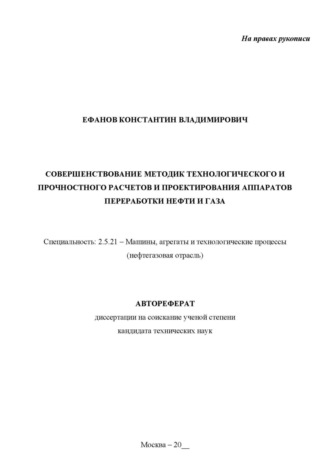ГОСТ Р МЭК 62366-1-2021. Национальный стандарт Российской Федерации. Изделия медицинские. Часть 1. Проектирование медицинских изделий с учетом эксплуатационной пригодности
БИБЛИОГРАФИЯ
[1] | IEC 60601-1:2005 <1> | Medical electrical equipment - Part 1: General requirements for basic safety and essential performance (Изделия медицинские электрические. Часть 1. Общие требования безопасности с учетом основных функциональных характеристик) IEC 60601-1:2005/Amd 1:2012 |
[2] | IEC 60601-1-6:2010 <2> | Medical electrical equipment - Part 1-6: General requirements for basic safety and essential performance - Collateral standard: Usability (Изделия медицинские электрические. Часть 1-6. Общие требования безопасности с учетом основных функциональных характеристик. Дополнительный стандарт. Эксплуатационная пригодность) IEC 60601-1-6:2010/Amd. 1:2013 |
[3] | IEC 60601-1-8:2006 <3> | Medical electrical equipment - Part 1-8: General requirements for basic safety and essential performance - Collateral standard: General requirements, tests and guidance for alarm systems in medical electrical equipment and medical electrical systems (Изделия медицинские электрические. Часть 1-8. Общие требования безопасности с учетом основных функциональных характеристик. Дополнительный стандарт: Общие требования к сигнальным системам) IEC 60601-1-8:2006/Amd 1:2012 |
[4] | IEC 60601-1-11: <4> | Medical electrical equipment - Part 1-11: General requirements for basic safety and essential performance - Collateral standard: Requirements for medical electrical equipment and medical electrical systems used in the home healthcare environment (Изделия медицинские электрические. Часть 1-11. Общие требования безопасности с учетом основных функциональных характеристик. Дополнительный стандарт. Требования к изделиям медицинским электрическим и медицинским электрическим системам, используемым для создания в помещении медицинской среды) |
[5] | IEC TR 61258:2008 | Guidelines for the development and use of medical electrical equipment educational materials (Руководство по разработке и использованию медицинских электрических изделий в обучающих материалах) |
[6] | ISO/IEC Guide 63:2012 | Guide to the development and inclusion of safety aspects in International Standards for medical devices (Руководство по разработке и включению аспектов безопасности в международные стандарты на медицинские изделия) |
[7] | ISO 7010:2011 | Graphical symbols - Safety colours and safety signs - Registered safety signs (Графические символы. Цветовые и звуковые сигналы опасности) |
[8] | ISO 9000:2005 | Quality management systems - Fundamentals and vocabulary (Системы менеджмента качества. Основные положения и словарь) |
[9] | ISO 9001:2008 | Quality management systems - Requirements (Системы менеджмента качества. Требования) |
[10] | ISO 9241-11:1998 | Ergonomic requirements for office work with visual display terminals (VDTs) - Part 11: Guidance on usability (Эргономические требования к офисным дисплеям. Руководство по юзабилити) |
[11] | ISO 13485:2003 | Medical devices - Quality management system - Requirements for regulatory purposes (Изделия медицинские. Системы менеджмента качества. Требования для целей регулирования) |
[12] | ISO/TR 16142:2006 | Medical devices - Guidance on the selection of standards in support of recognized essential principles of safety and performance of medical devices (Изделия медицинские. Руководство по выбору стандартов в поддержку признанных важнейших принципов обеспечения безопасности и функциональных характеристик медицинских изделий) |
[13] | ANSI/AAMI HE 48:1993 | Human factors engineering guidelines and preferred practices for the design of medical devices |
[14] | ANSI/AAMI HE 74:2001 | Human factors design process for medical devices |
[15] | ANSI/AAMI HE 75:2009 | Human factors engineering - Design of medical devices |
[16] | EN 1041:2008 | Information supplied by the manufacturer of medical devices (Изделия медицинские. Информация, предоставляемая изготовителем) Amd. 1:2013 |
[17] | GHTF SG2N31R8:2003 | Global Harmonization Task Force (GHTF), Study Group 2 (SG2), Medical Device Post Market Vigilance and Surveillance: Proposal for Reporting of Use Errors with Medical Devices by their Manufacturer or Authorized Representative |
[18] | BEYER, H., HOLTZBLATT, K. Contextual Design: defining customer-centred systems. Morgan Kaufmann Publishers Inc, San Francisco CA, 1998 | |
[19] | BROWN, D. The challenges of user-based design in a medical device market. In D. Wixon and Ramey (Eds.), Field Methods Casebook for Software Design. New York: Wiley, 1996, pp. 157 - 176 | |
[20] | CALLAN, J.R., KELLY, R.T., QUINN, M.L., MOORE, R.A., GWYNNE, J.W. III, CHIN, E. MUCKLER, F.A., KASUMOVIC, J., SAUNDERS, W.M., LEPAGE, R.P., SCHOENFELD, I., and SERIG, D.I. (1995) Human factors evaluation of remote afterloading brachytherapy. (NUREG/CR-6125, Volumes 1 - 3) Washington, D.C.: U.S. Nuclear Regulatory Commission | |
[21] | COOKE, N.J. Varieties of knowledge elicitation techniques. Int'l J Human-Computer Studies. 1994:41, pp. 801 - 849 | |
[22] | DRURY, C.G., PRABHU, P., and GRAMOPADHYE, A. Task analysis of aircraft inspection activities: Methods and findings. Proceedings of the Human Factors Society 34th Annual Meeting. Santa Monica, CA: Human Factors and Ergonomics Society. 1990, pp. 1181 - 1185 | |
[23] | DUMAS, J. and REDISH, J.A Practical Guide to Usability Testing (Revised Edition), Exeter, UK, Intellect, 1999 | |
[24] | ELLIS, S.R., BEGAULT, D.R., and WENZEL, E.M. Virtual environments as human-computer interfaces. In M.G. Helander, T.K. Landauer, and P.V. PRABHU (Eds.), Handbook of human-computer interaction. Amsterdam: Elsevier. 1997, pp. 163 - 201 | |
[25] | FLEISHMAN, E.A., and QUAINTANCE, M.K. Taxonomies of human performance: The description of human tasks. Orlando: Academic Press, 1984 | |
[26] | GUNDRY J.W, COMESS K.A, Derook F.A, JORGENSON D, BRADY G.H. Comparison of naive sixth-grade children with trained professionals in the use of an automated external defibrillator. Circulation. 2000 Nov 14; 102(20):E166 | |
[27] | KIRWAN, B. and AINSWORTH, L.K. A Guide to Task Analysis. London, UK: Taylor & Francis, 1992 | |
[28] | HOLTZBLATT, K., and JONES, S. Contextual inquiry: Principles and practice. In D. Schuler and A. Namioka (Eds.), Participatory Design: Principles and Practice. Hillsdale, NJ: Erlbaum (1993) | |
[29] | JONASSEN, D.L., HANNUM, W.H., and TESSMER, M. Handbook of Task Analysis Procedures. Westport: Greenwood Publishing Group, 1989 | |
[30] | KLEIN, G.A., ORASANU, J., CALDERWOOD, R., and ZSAMBOK, C.E. Decision Making in Action: Models and Methods. Norwood, New Jersey: Ablex Publishing Corp, 1993 | |
[31] | LAUGHERY, K.R. Sr., and LAUGHERY, K.R. Jr. Analytic techniques for function analysis. In G. Salvendy (Ed.), Handbook of Human Factors. New York: Wiley, 1987, pp. 330 - 354 | |
[32] | LOEB, R., WEINGER, M.B., and ENGLUND, C.E. Ergonomics of the anesthesia workspace. Ehrenwerth, J. and Eisenkraft J.B., editors. Anesthesia Medical device: Principles and Applications. Mosby Year Book, Malvern, PA. 1993, pp. 385 - 404 | |
[33] | MEISTER, D. Behavioral Analysis and Measurement Methods. New York: John Wiley & Sons, 1985 | |
[34] | NIELSEN J. Usability Engineering. San Diego: Academic Press, Inc, 1993 | |
[35] | REASON, J. Human Error. Cambridge, England: Cambridge University Press, 1990 | |
[36] | REDMILL, F. and RAJAN, J. Human Factors in Safety-Critical Systems. Oxford: Butterworth-Heinemann, 1997 | |
[37] | ROUSE, W.B. Designing for human error: Concepts for error tolerant systems. In H.R. Booher (Ed.), MANPRINT: An approach to system integration. New York: Van Nostrand Reinhold, 1990 | |
[38] | RUBIN, J. Handbook of Usability Testing: How to Plan, Design, and Conduct Effective Tests, New York, NY, Wiley, 1994 | |
[39] | SCHULER, D. and NAMIOKA, A. Participatory Design: Principles and Practices. HILLSDALE, NJ: Lawrence Erlbaum Associates, 1993 | |
[40] | SHARIT, J. Allocation of functions. In G. Salvendy (Ed.), Handbook of Human Factors and Ergonomics, 2nd edition, New York: Wiley, 1997, pp. 301 - 339 | |
[41] | SINCLAIR, M.A. Subjective assessment. In J.R. Wilson and E.N. Corlett (Eds.), Evaluation of human work. London: Taylor & Francis. 1990, pp. 58 - 88 | |
[42] | WIENER, E.L., and NAGEL, D.C. (Eds.) Human factors in aviation. San Diego: Academic Press, 1988 | |
[43] | WEINGER, M.B., HERNDON, O.W., and GABA, D.M. The effect of electronic record keeping and transesophageal echocardiography on task distribution, workload, and vigilance during cardiac anesthesia. Anesthesiology 1997, 87:144 - 155 | |
[44] | WEINGER, M., WIKLUND, M. and GARDNER-BONNEAU, D.A Handbook of Human Factors in Medical Device Design, Boca Raton, FL, CRC Press, 2011 | |
[45] | WIKLUND, M., KENDLER, J., and STROCHLIC, Usability testing of Medical devices, Boca Raton, FL, CRC Press, 2010 | |
[46] | ZHANG, J., PATEL, V.L., JOHNSON, T.R., CHUNG, P., and TURLEY, J.P. Evaluating and predicting patient safety for medical devices with integral information technology. In Advances in Patient Safety (vol. 2), Washington, DC: AHRQ. 2005, p. 323 | |
--------------------------------
<1> Существует консолидированная версия 3.1(2012), включающая IEC 60601-1:2005 и поправку 1:2012.
<2> Существует консолидированная версия 3.1(2013), включающая IEC 60601-1-6:2010 и поправку 1:2013.
<3> Существует консолидированная версия 2.1(2012), включающая IEC 60601-1-8:2006 и поправку 1:2012.
<4> Издание 2, подлежит опубликованию.

 Подписаться на обновления
Подписаться на обновления